To say April Sproule is a ‘mixed media textile artist’ is an understatement. Just take a look at the captions for her work, and you’ll see what we mean. Each piece features a compelling array of techniques and materials, including hand stitch, dyeing, printing, painting, appliqué, stencilling, and inkwork.
You might think such extensive mashups could lead to art that overwhelms, but that’s hardly the case. April expertly balances colour and composition to create cohesive works that are surprisingly neat at first glance. Even upon close inspection, April’s layers of texture and pattern seamlessly merge and often surprise the eye.
In addition to offering us a look into her process and favourite things, April also shares how renowned UK textile artists helped her discover the power of simple stitches and inspired her to let go of her need for control. She explains how Constance Howard and others have taught her that self-expression doesn’t have to be complicated when it comes to stitchwork. And we think you’ll agree.
Apron strings
My earliest memory of making something with textiles is making an apron with my maternal grandmother, Grandma Ollie, when I was seven years old. She was a tiny woman who lived in a small house filled with things she had made. She loved to sew, knit and paint.
I remember carefully cutting out the apron on her kitchen table and sewing it on her portable Singer sewing machine. Her patience was infinite as she taught me those brand-new skills. I was amazed we had made something useful out of seemingly nothing with a scrap of fabric and some thread.
Around the same time my paternal grandmother, Grandma Petersen, began teaching me to do hand sewing and stitching. She taught me how to cut old clothing into squares using a cardboard template. Those hand-pieced squares would later become a quilt top. She also taught me hand embroidery and lace making.
I have very fond memories of being sequestered away in one of their homes on rainy winter days happily stitching away for hours. It’s no wonder sewing and stitching are now like breathing to me. They are something I have always done, and those basic skills would go through many transformations in years to follow. Back then, I had no idea how those early experiences would impact my life.

UK inspiration
During high school, I participated in a work study programme that involved writing a business plan and starting my first little business. I set about making a variety of leather goods, clothing and bags to sell at local shops and galleries.
After learning the technical skills I badly needed at the San Francisco School of Fashion Design, I worked for several different US and Canadian manufacturers. My area of expertise was new product development and production management for companies making leather goods, accessories and clothing. Since 2001, I’ve been a full-time studio artist working as both a designer and workshop facilitator.
In 2011, I developed a commercial collection of 25 stencil designs inspired by the Japanese Katagami stencils for painting on fabric. I began using the stencils for all sorts of things while teaching my painting techniques to others. I started making upcycled clothing for myself and linen bags to sell with the stencils, and then I added hand stitching to them. The stencilling and hand stitching worked well together. Next came a collection of hand embroidery patterns and kits in 2015.
Shortly after that, I started seeing online images from UK textile artists who were doing amazing work using hand stitching. I was especially inspired by Mandy Pattullo, Claire Wellesley-Smith, Louise Baldwin, Cas Holmes and Aideen Canning. These incredible women not only eradicated the notion of creating perfect little stitches, but they used stitching in such an expressive and expansive manner. Theirs was a much freer and innovative style of hand stitch that appealed to me on many levels.
I admired those artists’ ability to move away from the expected and express their own unique, wild and wonderful styles. It was as if a door had opened, and anything was possible on the other side of that threshold. My new norm became letting go of the need for control and embracing the idea of self-expression.
Upon further investigation, everything led back to the work and influence of Constance Howard. I pored over her books, and my entire perspective on hand stitching changed tremendously. I didn’t necessarily change the stitches I used, but I became mindful of how those stitches were used. One simple stitch could be used in 20 or more different variations.
When I developed my collection of hand embroidery patterns, I thought using lots of different complex or unusual stitches added more interest.
But after studying Constance Howard’s approach, I realised the complexity of stitches wasn’t as important as I thought. It was more about starting with one simple stitch and then tweaking it, contorting it, and reimagining all its possibilities.
Now as I go back and look through Constance’s books, I especially love seeing her illustrations. These days I see hand stitching as another form of mark making. And as I switch back and forth between pen and ink illustration and my hand stitching, each medium provides inspiration for the other.


Natural inspirations
I am inspired by many things, but my greatest inspiration comes from nature. Nature provides me with a never-ending treasure trove of ideas. It could be insects, botanical specimens or even diatoms and other microscopic images that pique my interest and beg me to take a closer look.
I live in an astonishingly diverse beautiful area in northern California. In just a few minutes, I can be exploring tide pools along our rugged coastline or trek deep into a Redwood forest where rays of sunlight pierce the thick canopy of branches and illuminate the areas below in a spectacular display.
I’m more interested in capturing the essence of my subject matter than in replicating it in a photorealistic way. And things that are in a state of erosion or decomposition are much more interesting than a perfect specimen.
Surface design with textiles, pen and ink illustration, printmaking, collage, and watercolour are all mediums that supply me with lots of ideas and inspiration.


Creative process
My work is developed in different ways, but it usually begins with a feeling or mood I want to convey. Early in the morning, I often work in a little handmade book where I experiment with different ways of combining paper, fabric and stitch in new and interesting ways that can lead to larger projects.
Often my work begins with what I call a production sketch. It’s just a vague idea and a starting point, but it’s a very important step because it takes what only exists in my mind into the physical world where it becomes tangible.

Next comes colour, which is one of the most valuable design elements. Colour is what first attracts or repels viewers to our work. I usually start with white fabric or pieces on which I’ve applied some sort of surface design techniques.
Scale, the overall finished size of the piece, comes next. Are the details going to be lost if a person sees it from a distance? Those choices inform all my decisions on which mediums to use.
In recent years, I’ve worked much more intuitively. All I need is one idea to get started. It could be the colour green and then everything develops from there. Every piece I make takes me on a journey of learning and exploration I would never have experienced if I’d planned every step along the way.
I feel incredibly fortunate because I rarely get really stuck on a piece and give up on it. I am good at problem solving and figuring things out. It seems like a waste of time, energy and materials to give up on a piece and not finish it.
When I start a new project that is very involved, I clean up my studio and put everything in its place. Initially clutter can be a distraction, but that’s only in the beginning. Once my ideas start to flow, it is total chaos. I don’t clean up until the project is completely done.

Mixing things up
I use a wide variety of mixed media on fabric and paper. I especially enjoy working with dyes, paints, stencilling, printing, pen and ink, cyanotypes, and hand or machine stitch. Learning to do all of these things has been so much fun!
I’ve done lots of shibori dyeing with Procion dyes and indigo over the years. It’s so exciting to unwrap the cloth and see what has happened. And now I have all those fabrics to choose from and add to my textile art.
Using paints and inks on fabric and paper has been a great addition to my work. I use textile paints that don’t alter the hand of the fabric, and I’m pretty picky about that. I also love using walnut ink, sumi ink and India inks. Sometimes I just sit and draw stripes or dots with a pen or brush. Then it’s fun finding new ways to incorporate those pieces into my work.
I am also experimenting a lot with different papers. I won’t use papers that are either too delicate or too hard to stitch through. I still have a lot to learn about different types of paper, but that’s part of the research and excitement of learning something new.


Must-have favourites
My absolute favourite fabrics to work with are linen, cotton sateen and silk. I use both vintage and new fabrics, but many of the vintage fabrics are just wonderful to work with. The linen is like butter to stitch through, and I love the texture of it.
My next favourite fabric is cotton sateen, as the weave gives it a subtle sheen. It has a very nice hand, dyes beautifully and it is really easy to stitch through. And silk has long been a favourite of mine. I don’t ever use fusibles on it, as that would ruin the hand of the fabric. I have lots of silk left over from having a custom sewing business for 10 years. Now, I’m glad I saved all those fabrics.

For threads, I mostly use DMC cotton along with some hand-dyed threads. I‘d like to try linen thread but haven’t yet. My favourite stitches are the running stitch, stem stitch, straight stitches, rice stitch, couching, and the versatile blanket stitch. I also like the cretan stitch a lot, because it can be used in lots of different ways.
I took Sue Stone’s Exploring Texture and Pattern course in 2018. After finishing all the exercises, my style of stitching changed from using more complex decorative stitches to using very basic stitches in different forms and combinations. My needle has become like my pen, and my hand stitching is now another form of mark making.
One of the greatest things about hand embroidery is you only need a few basic tools. And I enjoy using good quality tools that last a long time, so I don’t have to replace them.
Really sharp scissors are very important. I have embroidery, appliqué, regular scissors, paper scissors and huge shears for cutting heavy fabrics. But mostly I just need a sharp little pair of embroidery scissors for cutting threads.
Fabric markers are also important. I use Frixion markers and have never had a problem with them. I like that I get nice clean lines with them. And of course, good needles make everything so much easier. I use mostly size 10 embroidery needles with a nice sharp point.
I do almost all of my actual stitching at night. I use a large floor model OttLite, and I could not sew without it. I usually do hand stitching for three hours or so every night. It’s become a daily practice I really enjoy.
My iPad is my favourite design tool. I use an app called Adobe Fresco for my illustrations. I start a piece, photograph it, and then draw mock up stitches on the photo to help with design options and decisions. I can add 10 layers of stitching, eliminate what I don’t like, airdrop the image to my phone, and use it for reference as I stitch. It’s just like magic!


Silver linings
The biggest challenges I’ve faced as a professional artist were Covid related. From 2001-20, I operated a longarm quilting business, sold my wares online and as a vendor at shows, and I taught workshops on techniques I’d developed over the years. 2019 was an especially busy year for me. Then Covid reared its ugly head, and every single upcoming event I had scheduled was cancelled.
I decided to make the most of this unexpected free time by focusing on my art and volunteering for different textile art groups who were supporting artists and textile art instructors. That gift of time gave me a chance to reevaluate what I was doing and make some positive changes.
I closed my longarm quilting business and decided to stop vending at shows and started applying for grants. In 2019, I received a grant from a local arts foundation, and in 2020, I received a business grant from the state. Collectively, those funds made it possible for me to gain the technical training and equipment I needed to start teaching online.
Now my goal is to spend half my time working and the other half creating art. I’m not there yet, but I will be some day. It’s also much easier to share what I do with others and help others achieve their creative goals.
My biggest artistic challenge was making the portraits in Sue Stone’s Stitch Your Story online course. I had no interest whatsoever in stitching portraits, but I knew what a fabulous teacher Sue was. It was really hard, but I learned so much along the way. I was really inspired by the work of the others in the course.
I think one of the best things you can do as an artist is try things outside of your comfort zone. That is the best way to grow your skills and your proficiency in any medium.


Designing my creative space
After leasing a commercial building for five years for my business and studio, I finally had a studio built behind my house in 2006. I needed room for my 14ft longarm quilting machine, space to teach my surface design workshops and a workspace for me to create my textile art.
I had lots of experience designing textile art projects, but designing a building was an entirely different experience. Luckily, I found a great designer and very good contractors to work with me.
The 24ft x 40ft (7.3m x 21.1m) two-story structure has nice high ceilings. Downstairs is my wet studio where I do my messy stuff like dyeing and fabric painting. I included a 6ft-wide stainless steel sink from a place that carried used restaurant equipment, and it has been a useful addition. There’s also lots of storage for art supplies and other stuff.
Upstairs is one large room where I sectioned off a full bathroom and walk-in closet. The kitchen area has cabinets that hold art supplies, and it was designed to accommodate appliances, but I would rather have the space.
One of my requests was to have lots of natural light. But I also needed wall space for art display and a large design wall. The designer was able to plan accordingly, so I have windows on three sides and plenty of wall space in between.
I had a 4ft x 8ft cutting table built with storage cabinets and shelving below. I knew my needs for this space would change over the years, so one of the best things I did was to outfit all my heavy equipment, like the cutting table and longarm machine, with heavy duty casters so I can easily move things around by myself. That has been a tremendous help.
The building is quite tall due to the high ceilings on each level, so I had a manual dumb waiter added to transport heavy items, like sewing machines, up to the second floor. We’ve had lots of great workshops and retreats here, and that dumb waiter has gotten a lot of use over the years.
Every morning I wake up really early, grab a strong cup of coffee, and head over to the studio. When time permits, I sit and draw for an hour in front of my big window before I start my day. I’m grateful for every moment I spend here. My family has always been very supportive of what I do, and none of this would’ve been possible without them.


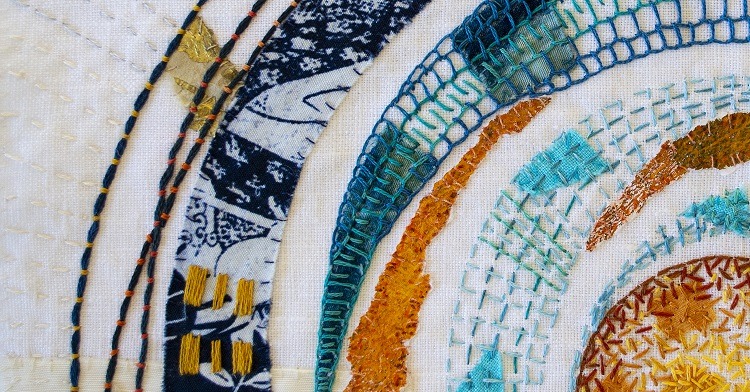
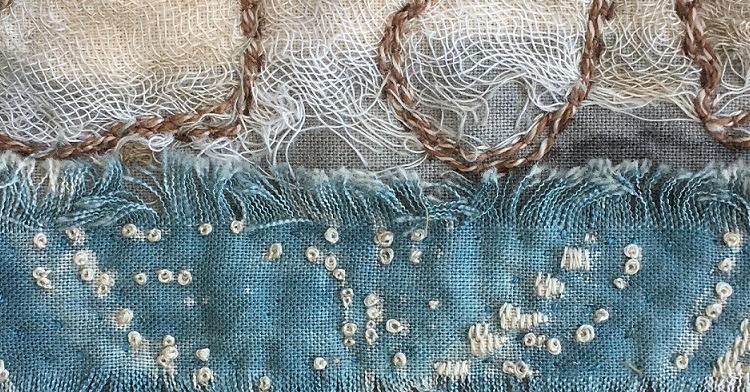
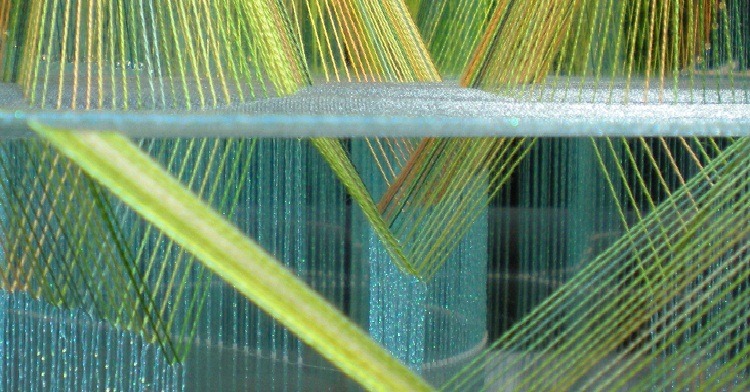
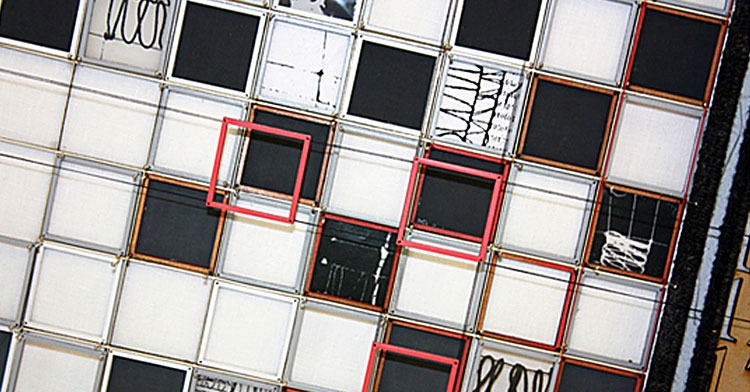
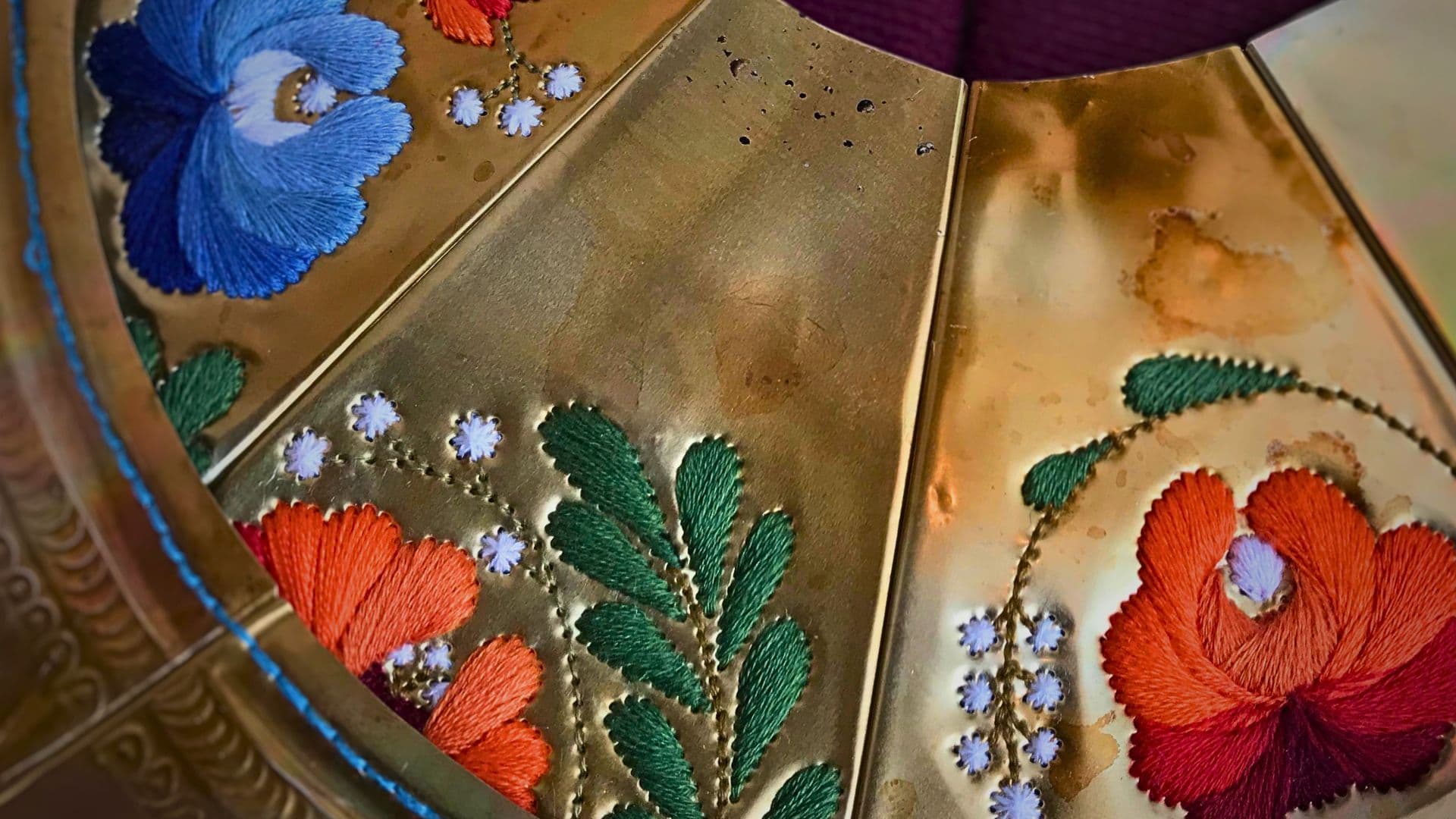
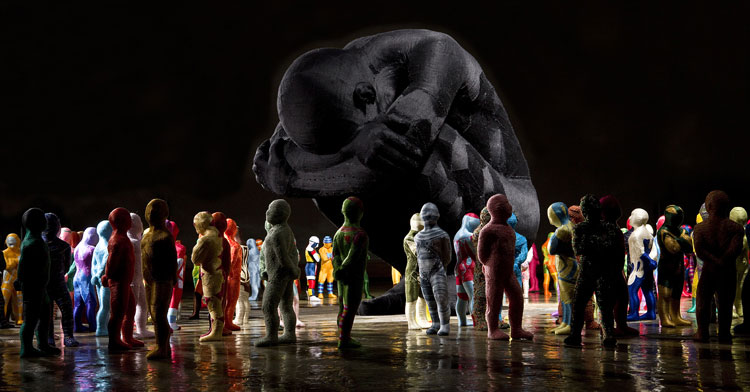
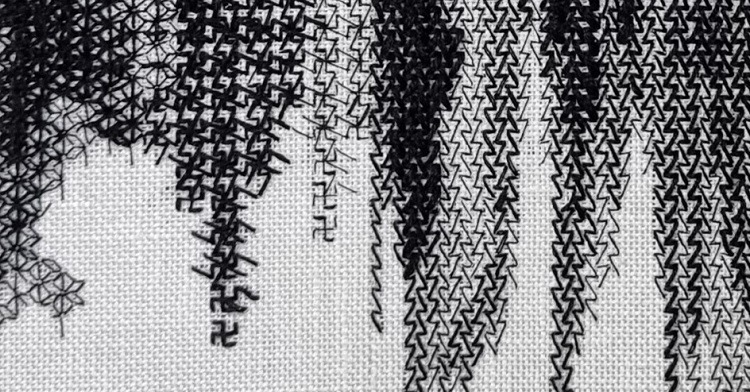
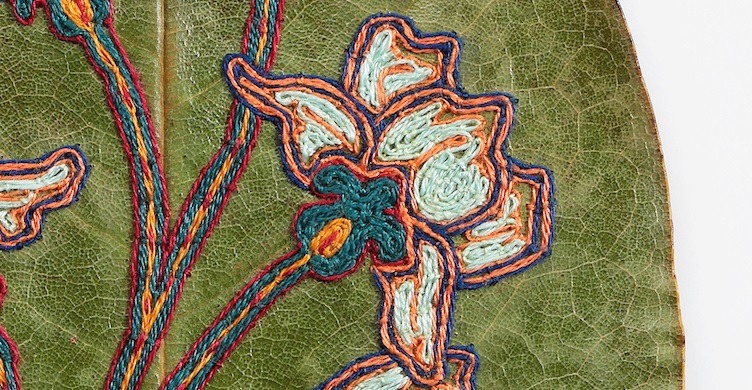
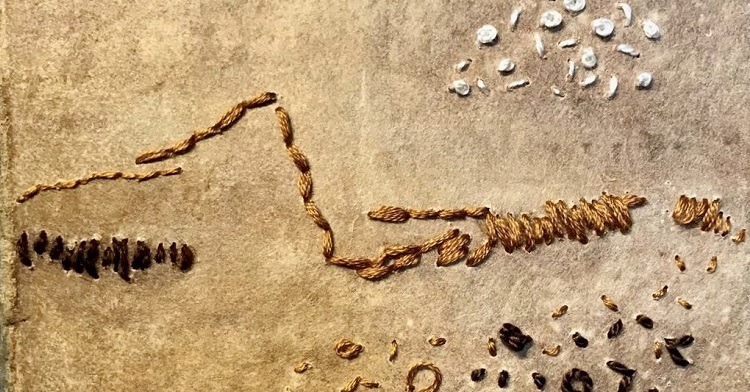
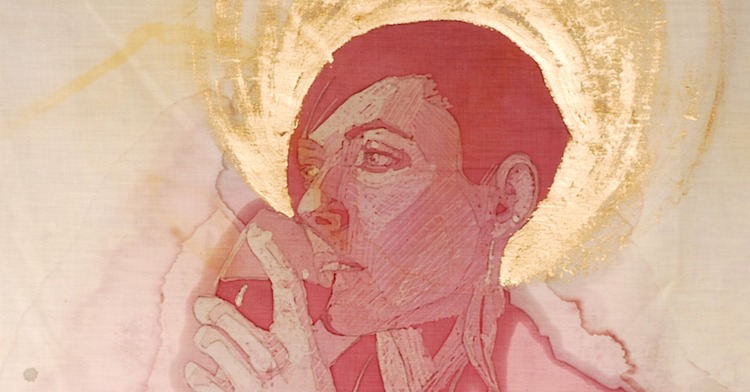
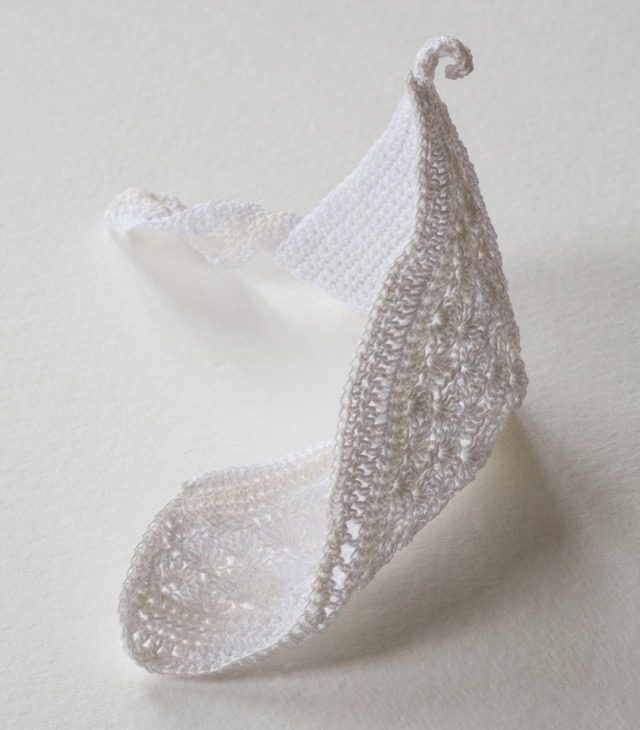
11 comments
Winifred Willcox
Totally inspired by your talent & generous sharing ….sewing is my therapy & your article has sewn hope & joy today. Thank you so much April
April Sproule
Dear Hazel,
A million thank yous are in order for your lovely response to this article. It is never too late to begin your creative journey. You can start right now with whatever you have. A trip to a thrift store to pick up used linens, a couple of skeins of thread, and a pack of needles will get you started in good order! Follow your heart, and amazing things will happen for you.
Hazel Jamieson
I read this article and felt my heart start to race. Its like opening a door to a home that I’ve always wanted to exist in! I was drawn into every visual piece of work and immediately felt myself wondering how I could recreate this…yearning go learn the techniques and find my own voice too. How I wish I’d followed this passion inside me far earlier in life. I’m 64yrs old and have had this longing inside me as far back as I can remember but life has pulled me in different directions. Time is now available but finances sadly not. I still love to feed my eyes and soul on beautiful artwork such as these…THANK YOU
April Sproule
Dear Hazel,
A million thank yous are in order for your lovely response to this article. It is never too late to begin your creative journey. You can start right now with whatever you have. A trip to a thrift store to pick up used linens, a couple of skeins of thread, and a pack of needles will get you started in good order! Follow your heart, and amazing things will happen for you.
Gill Tyson
A totally inspiring article, thank you April and thank you textileartist.org. I love April’s work and have really enjoyed reading about her experiences and design processes – a lot of great take-aways from this article. Her Stitch Club workshop is wonderful!
The signposting to Bobbi Baugh at the end is also great for anyone not familiar with her work – another wonderful surface design/textile artist. Might there be a SC workshop in the offing with Bobbi?
Lindy Gibbon
Happy New Year.
Thank you for another fabulous and inspiring article.
I loved learning about April’s process and am going to replicate her discipline around capturing ideas in a sketchbook and trying out simple stitches in different ways. Excellent!
April Sproule
I am glad you found some useful info you can out into use Lindy. I hope you enjoy working in your sketchbook and exploring new ideas.
April Sproule
Thank you very much Gill.
Barbara Ellis
Fabulous, inspiring article! I’ve loved following news of April’s beautiful creations since she was a student in my drawing class nearly 20 years ago.
April Sproule
Amazing isn’t it Barbara how we all just keep moving forward. Thank you for your kind comments!
Julie Short
What a brilliant article.